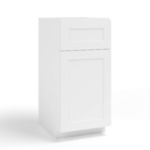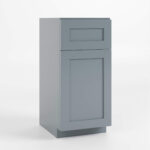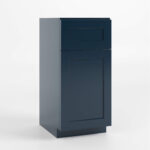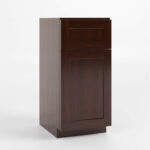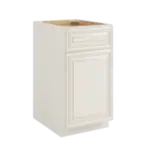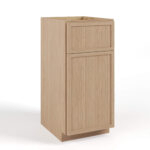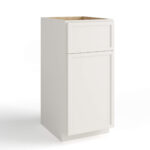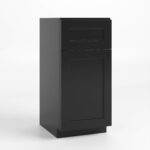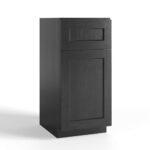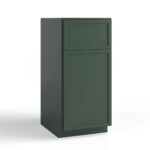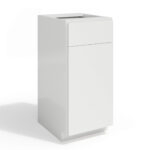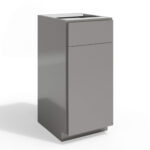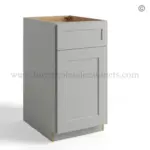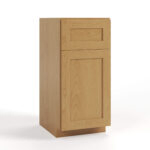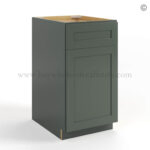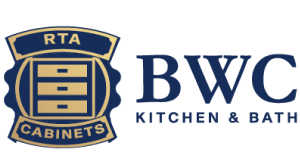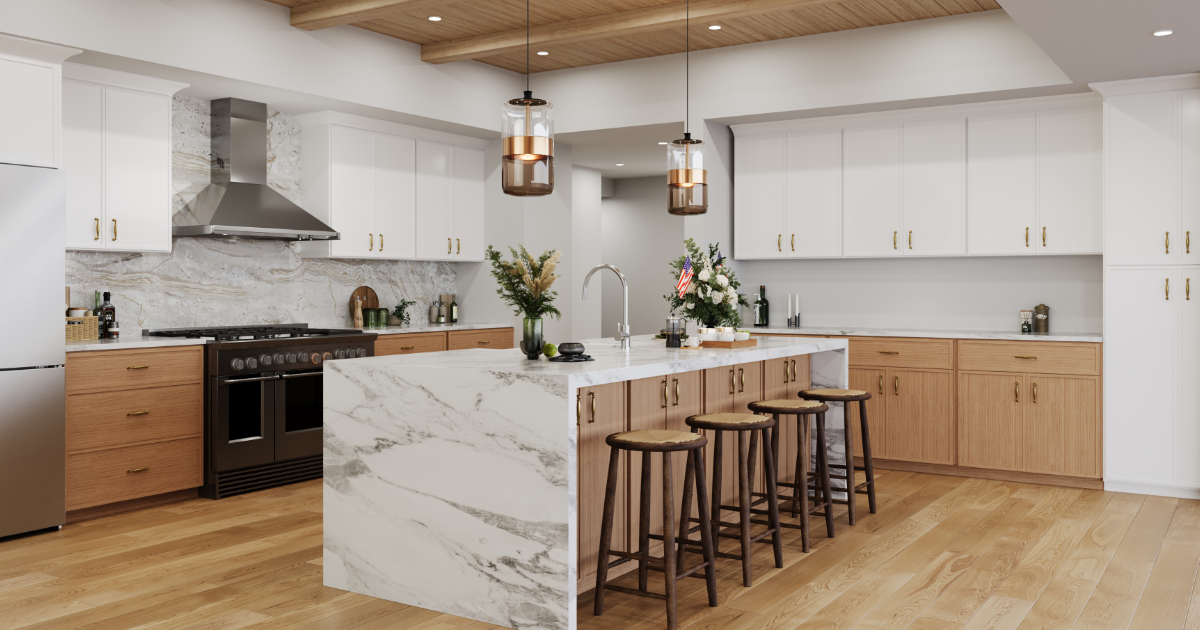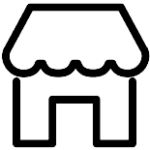Table of Contents
A well-designed kitchen is the heart of any home, and cabinets lie at the core of a functional and stylish kitchen. They are far more than storage. They define the layout, style, and workflow of your kitchen. From organizing cookware and pantry essentials to choosing the right materials and finishes, understanding kitchen cabinets is essential for both functionality and aesthetics.
This guide to kitchen cabinets offers an in-depth review of the types, materials, doors, styles, trends, colors, costs, installation, maintenance, and more.
Whether you are remodeling, building a new kitchen, or simply optimizing your storage, this guide will help you make informed decisions to create a beautiful, durable, and efficient kitchen.
What Are Kitchen Cabinets?
Kitchen cabinets are specialized storage units designed to organize and protect kitchen items. They provide a practical solution for storing cookware, utensils, appliances, pantry items, and cleaning supplies. Beyond storage, they play a key role in shaping the overall look and feel of your kitchen. Their design affects workflow, accessibility, and even the perceived size of the kitchen.
Well-designed cabinets keep countertops clutter-free, ensuring a clean and functional workspace. They also enhance kitchen ergonomics, making it easier to reach frequently used items while preparing meals. Modern kitchens feature cabinets in various sizes, materials, and finishes, allowing homeowners to tailor their kitchen to personal taste and lifestyle needs.
For example, a compact kitchen may benefit from vertical storage, pull-out shelves, and tall pantry cabinets. They are perfect for maximizing every inch of the available space. A spacious kitchen may accommodate a mix of base, wall, and island cabinets for maximum storage. Additionally, cabinets can integrate technology, like soft-close drawers, under-cabinet lighting, and smart organizational solutions.
Types of Kitchen Cabinets
Understanding the types of kitchen cabinets is the first step in planning an efficient and stylish kitchen layout. Cabinets can be categorized based on their location, design, and functionality. Some of the most popular types of kitchen cabinets include the following:
Base Cabinets
Base cabinets sit directly on the kitchen floor and form the foundation for countertops. They are ideal for storing heavy items like pots, pans, mixers, and small appliances. As they accommodate essential items used for cooking and food preparation, base cabinets often determine the overall workflow of the kitchen.
Features:
- Can include drawers, shelves, pull-out baskets, and corner solutions
- Often used for built-in sinks or dishwashers
- Provide structural support for countertops
- Offer flexibility with a modular design to fit awkward spaces
Tip: Place frequently used heavy cookware in lower drawers to prevent lifting strain. Consider pull-out drawers with dividers for pots and pans, as they help maintain quick access while keeping everything organized.
Example: In a kitchen with a large base cabinet under the stove, storing heavy pots and pans close to the cooking area can improve workflow and reduce fatigue during meal preparation.
Wall Cabinets
Wall cabinets are mounted above countertops, maximizing vertical space and providing storage for lighter items. They are perfect for dishes, glasses, cups, spices, and small appliances. Wall cabinets also play a crucial role in improving the aesthetics, shaping the kitchen’s visual impact.
Features:
- Can extend to the ceiling for additional storage and a built-in look
- Ideal for incorporating glass-front doors to display dishware and decorative items
- May include built-in lighting underneath for enhanced workspace illumination
- Can be designed with adjustable shelves to accommodate different item sizes
Tip: Keep everyday items in these cabinets at eye level for easy reach, and reserve higher shelves for items used less frequently, such as seasonal serving platters or rarely used appliances.
Example: Installing LED lights under wall cabinets enhances visibility on countertops and adds a modern touch to the kitchen design.
Pantry Cabinets
Pantry cabinets are tall, often floor-to-ceiling units that store dry food, canned foods, and small appliances. These cabinets help consolidate food storage and reduce clutter on the counters. Many pantry cabinets also feature adjustable shelves, pull-out drawers, and built-in organizers to categorize items, maximize space, and maintain an organized and accessible kitchen.
Features:
- Can include adjustable shelves, pull-out trays, or rotating shelves
- Helps reduce countertop clutter by providing dedicated storage for frequently used items
- Can double as an appliance cabinet for microwaves, coffee makers, or mixers
- Offers hidden storage solutions for a clean and streamlined look
Tip: Allocate at least one pantry cabinet in larger kitchens to consolidate all food storage in one accessible area. Use labeled baskets or containers to categorize items for food access.
Example: A pull-out pantry with deep shelves allows you to store canned goods, cereals, and spices in a compact space while remaining fully visible and accessible.
Vanity Cabinets
While vanity cabinets are often associated with bathrooms, they are finding increased adoption in kitchens as well, particularly in islands or compact areas. They provide additional storage and house sinks or small appliances while hiding cleaning supplies. Their versatility is ideal for kitchens with limited space, offering both style and practicality. These cabinets can also be customized with decorative panels, handles, or finishes to complement the overall kitchen aesthetic, making them both functional and visually appealing.
Features:
- Compact and versatile for small kitchens or island kitchens, perfect for maximizing limited space.
- Can be used as standalone units or seamlessly incorporated into larger cabinet systems for cohesive design.
- Offers stylish design elements while maximizing hidden storage, keeping the kitchen organized and clutter-free.
- Can include drawers, shelves, or doors for organized storage of utensils, napkins, small appliances, and cleaning products.
- Often designed with customizable options, such as pull-out racks or adjustable shelves, to suit specific storage needs.
Tip: Combine vanity-style cabinets with drawers or organizers for versatile storage, keeping small items like cutlery, dish towels, cleaning tools, and kitchen gadgets neatly tucked away. Consider grouping related items together for easier access and a more efficient workflow.
Example: A kitchen island with a built-in vanity cabinet under the sink allows for discreet storage of cleaning supplies, small appliances, and frequently used utensils, making the kitchen appear organized, spacious, and clutter-free.
Want to explore more about types of kitchen cabinets? Discover detailed comparisons of cabinet materials, layouts, and design styles to help you choose the best fit for your kitchen.
Most Common Types of Kitchen Cabinet Materials
The materials used in kitchen cabinets determine durability, style, maintenance, requirements, and cost. Choosing the right material is essential for longevity and functionality. Different materials also affect the overall aesthetic, weight, and ease of installation. Selecting the appropriate material ensures cabinets withstand daily use, resist moisture or warping, and complement the kitchen’s design while providing long-term value and practicality.
Plywood
Plywood is made from layers of wood veneer glued together, with each layer running perpendicular to the previous one, giving the board strength and stability. Due to its combination of durability, versatility, and aesthetic appeal, plywood is one of the most popular choices for constructing kitchen cabinets.
Plywood can be used for cabinet boxes, shelves, and even drawer panels, making it a highly flexible material for both modern and traditional kitchens. It is also less prone to warping compared to solid wood when exposed to humidity, which is particularly important in areas near sinks or ovens. Plywood can be stained, painted, or laminated to match various design styles, providing a wide range of customization options.
Advantages:
- Resistant to warping and cracking
- Strong enough to hold heavy items
- Suitable for both cabinet boxes and shelves
- Can be finished with veneer, laminate, or paint for different aesthetics
- Offers a lightweight alternative to solid wood while maintaining strength
Limitations:
- Can be more expensive than MDF or chipboard
- Quality varies depending on the grade, as lower grades may have voids or rough surfaces
- Edges may require additional finishing to prevent splintering
- Not completely impervious to water, as prolonged exposure can cause swelling if not sealed properly
Tip: Opt for high-grade plywood with a smooth finish for a durable and premium look. For cabinets near sinks, consider marine-grade plywood for extra moisture resistance. Reinforce corners and joints for additional stability in heavy-use areas.
Example: A kitchen with custom plywood cabinets can withstand daily wear while offering flexibility in design and finish. Homeowners often choose plywood for its balance of strength, versatility, and affordability, making it a long-term investment that supports both functionality and style in busy kitchens.
Chipboard-Laminated Panels
Chipboard, also called particle board, is made from wood particles bonded with resin and covered with laminate. It is a budget-friendly option for many kitchens, offering versatility in design and finish while keeping costs low. This material is ideal for homeowners seeking attractive cabinetry without a high investment.
Advantages:
- Cost-effective compared to plywood and solid wood
- Available in a wide range of colors, textures, and patterns
- Lightweight and easy to work with, making installation simpler
Limitations:
- Less resistant to moisture and heavy loads, making it vulnerable to swelling or damage in humid areas
- Not as strong as plywood or solid wood, making them unsuitable for holding heavy loads
- Edges can chip or peel if not properly sealed or finished
- Shorter lifespan compared to premium materials like plywood or solid wood
- Susceptible to sagging when used for wide shelves without reinforcement
- A laminate surface may get stretched or worn over time, requiring sooner replacement
Tip: Use chipboard-laminated panels for wall cabinets or in areas away from water exposure. Ensure edges are properly sealed to prevent moisture damage and prolong the life of cabinets.
Example: A kitchen using chipboard-laminated panels for upper cabinets can achieve a modern look with a wide selection of laminate finishes while keeping the project affordable. These cabinets work well for storing lighter items such as dishes, glasses, and pantry goods, making them a practical choice for budget-conscious renovations.
MDF (Medium Density Fiberboard)
MDF is manufactured by compressing wood fibers into dense panels. Its smooth surface makes it ideal for painted cabinets or intricate door designs.
Advantages:
- Excellent for intricate designs, smooth finishes, and painted surfaces
- Affordable alternative to solid wood
- Less prone to warping than natural wood
- Provides a consistent, uniform surface with no knots or grain irregularities
- Easy to cut, shape, and customize for unique cabinet designs
- Available in large sheets, allowing seamless cabinet construction with minimal joints
- Compatible with veneers and laminates for added durability and design flexibility
Limitations:
- Sensitive to water and humidity
- Heavier than plywood
- Susceptible to chipping or breaking when the screws are too tight
- Shorter lifespan than plywood or solid wood
Tip: Seal edges and avoid excessive moisture to ensure durability. MDF works well for modern kitchens with painted or lacquered finishes. For best results, pair this material with high-quality hardware and protective coatings.
Example: A sleek, modern kitchen with white-painted MDF shaker-style cabinets provides a smooth, flawless finish and a contemporary look at an affordable cost.
Solid Wood Materials
Solid wood cabinets are a classic choice for high-end kitchens. They offer natural beauty, durability, and long-term investment value. Common wood types include oak, cherry, birch, and maple.
Advantages:
- Can be refinished multiple times
- Strong and long-lasting
- Provides a timeless and elegant look
- Adds value to your home
Limitations:
- More expensive than plywood, chipboard, and MDF
- Prone to warping, shrinking, or expanding
- Requires regular maintenance
- Limited color uniformity
Tip: Solid wood is best for cabinet doors and face frames. Choose hardwoods for durability in high-use areas.
Example: A luxury kitchen with custom cherry wood cabinets creates a warm, elegant atmosphere with durability that lasts for decades when properly maintained.
Read our detailed guide to kitchen cabinet materials to learn how different materials impact the durability, style, and long-term value of your kitchen cabinets.
Types of Kitchen Cabinet Doors
The style and design of cabinet doors significantly affect the overall appearance of your kitchen. Door design impacts both aesthetics and functionality.
Flat-Panel (Slab) Doors
Flat-panel doors are smooth and featureless, offering a sleek and minimalist design. They are ideal for contemporary kitchens. Pair flat-panel doors with glossy finishes or bold colors to achieve a modern aesthetic. Consider adding handleless push-to-open mechanisms for a clean look.
Shaker-Style Doors
Shaker-style doors feature a recessed center panel and simple frame, combining functionality with understated elegance. Their simplicity makes them versatile across various kitchen designs. Paint shaker-style doors in neutral or bold colors to suit different kitchen styles. They also pair well with modern hardware to blend classic and contemporary elements.
Framed vs. Frameless Doors
Framed doors feature a front frame that provides structural support. Due to their traditional look, they are ideal for classic kitchens. Frameless doors are European-style cabinet doors that create a seamless and modern appearance.
Explore our comprehensive guide to types of kitchen cabinet doors to understand how design choices influence the aesthetics, durability, and functionality of your kitchen space.
Kitchen Cabinet Styles and Trends
Shaker Style
Timeless, simple, and functional, the Shaker style continues to be one of the most popular cabinet designs worldwide. It works well in both traditional and modern kitchens, combining a clean look with subtle detailing. Versatile in finish, they can be painted in neutral or bold tones, offering endless design possibilities.
Raised Panel Style
Raised panel cabinets feature a decorative center panel that adds depth, elegance, and sophistication to the design. Often used in classic or formal kitchens, they pair beautifully with crown molding and intricate hardware. This style works well with darker wood tones, bringing a sense of luxury and refinement to larger kitchens.
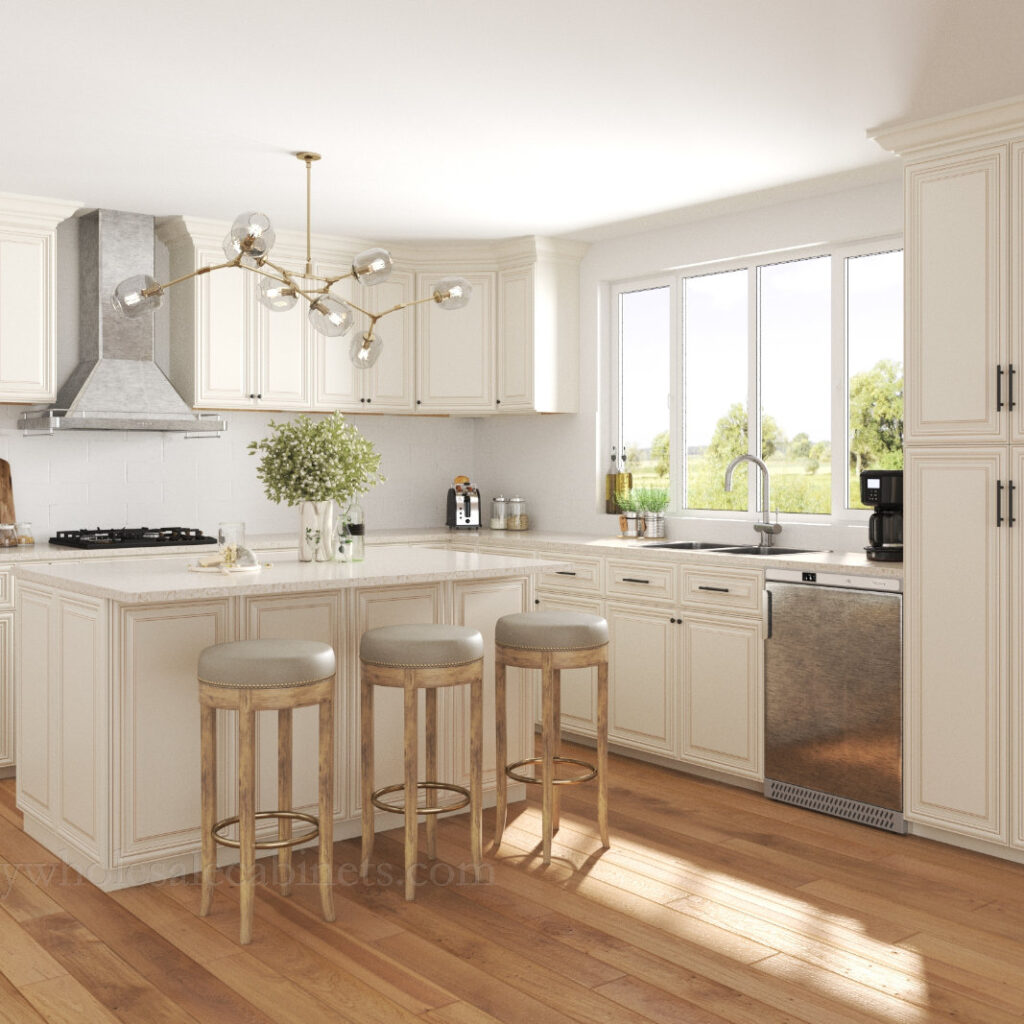
Framed Style
Framed cabinets showcase a visible front frame around the cabinet box, adding durability and structure. This traditional design offers strong construction and pairs well with detailed moldings for a classic aesthetic. Framed styles are popular in farmhouse, cottage, or rustic kitchens, where character and a handcrafted feel are important.
Frameless Style
Also known as European-style, frameless cabinets eliminate the face frame, maximizing interior space and creating a seamless, modern look. They work well with minimalistic designs that favor clean lines and efficiency. Popular in urban apartments and contemporary homes, frameless cabinets allow for easy access, adjustable shelving, and sleek, clean surfaces.
High Gloss Style
High-gloss cabinets feature reflective finishes that brighten the kitchen, making small spaces appear larger and more open. Popular in modern and minimalist kitchens, this style enhances light flow and creates a polished, high-end look. Easy to wipe clean, high-gloss finishes are practical, especially for busy households that prefer low maintenance.
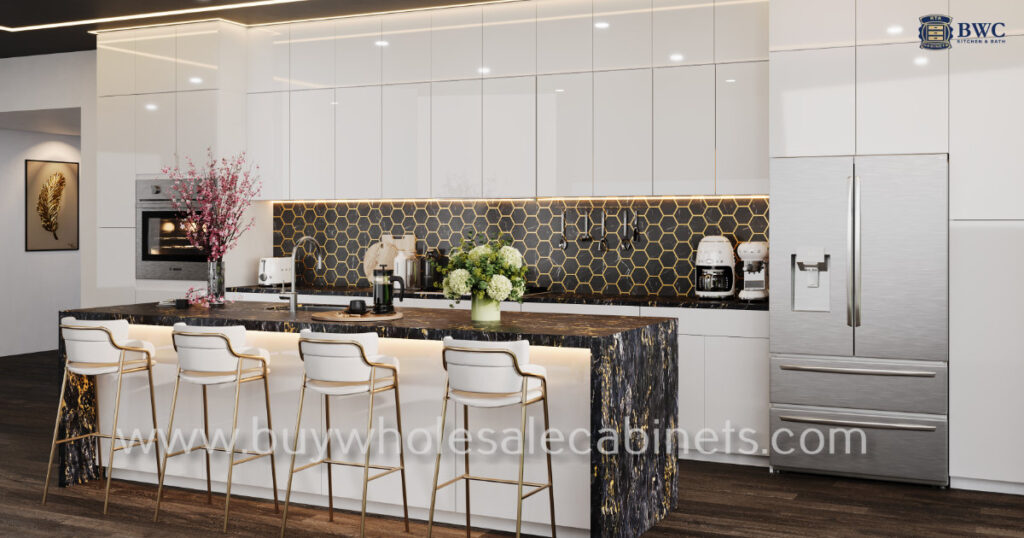
Two-Tone Designs
Two-tone kitchen cabinets combine different colors or finishes for upper and lower units, creating visual contrast and depth. This design trend blends functionality with style, often highlighting kitchen islands as focal points. For example, pairing white uppers with navy or black lowers can balance brightness. They are perfect for open-plan kitchens.
Read our detailed guide to kitchen cabinet trends to explore how different styles, finishes, and modern designs can enhance both the look and functionality of your kitchen.
Check out our detailed guide on trending kitchen cabinet colors for inspiration and expert tips.
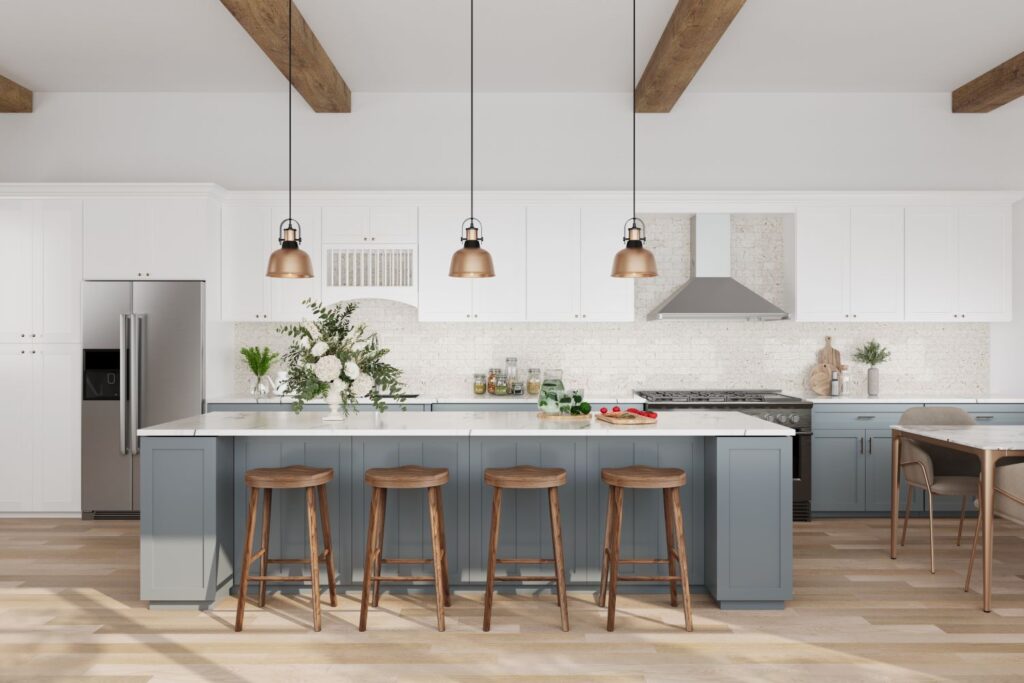
Trending Kitchen Cabinet Colors
Color impacts both mood and space perception. Popular color choices for kitchen cabinets include:
White
Bright and timeless, suits all styles, enhances spaciousness and cleanliness.
White Oak
The natural warmth and versatility of White Oak pair beautifully with both modern and rustic kitchens.
Gray
Sophisticated and neutral, it provides balance and complements a wide range of tones.
Blue
Bold yet calming, it adds personality while maintaining elegance in contemporary spaces.
Black
Dramatic, luxurious, and striking, it creates contrast with lighter countertops and backsplashes.
Green
Fresh and earthy, it brings nature indoors and is perfect for creating a grounded atmosphere.
Espresso
Deep, rich elegance, offering warmth, sophistication, and timeless appeal to kitchens.
Charcoal
Sleek, modern look, versatile enough to blend with bold or neutral accents.
Dark Tones
Navy, deep brown, and black for contemporary flair, depth, and sophistication.
Tip: Use lighter shades to make small kitchens appear larger and darker tones for dramatic or formal kitchens. Two-tone combinations can highlight islands or accent walls.
How Much Do Kitchen Cabinets Cost?
Costs vary depending on the material, brand, and customization. Here’s an overview:
- Stock Cabinets: $100 to $300 per square foot. Pre-manufactured, limited options.
- Semi-Custom Cabinets: $150 to $650 per square foot. Offer more flexibility in design and size.
- Custom Cabinets: $500 to $1200 per square foot. Fully tailored to space, design, and material choice.
Additional costs include hardware, installation, and finishing. When budgeting, consider future maintenance costs, as some finishes require more upkeep. Delivery fees, labor charges, and modifications for plumbing or appliances can also raise the total cost. Always request detailed quotes and compare vendors before making your final decision.
Explore our complete guide on kitchen cabinet costs to understand pricing differences between stock, semi-custom, and custom cabinets before you buy.
How to Choose the Right Kitchen Cabinets
Consider the following when selecting cabinets:
- Material Durability: Choose sturdy materials like plywood or solid wood for long-lasting performance, especially in high-use kitchens.
- Style and Design: Match your cabinets with your kitchen’s theme, whether modern, rustic, or traditional.
- Storage Needs: Plan for pots, pans, pantry items, and small appliances with shelves, drawers, or pull-outs.
- Budget: Decide between stock, semi-custom, or custom cabinets based on your financial capacity.
- Maintenance Requirements: Select finishes that are easy to clean and resistant to stains, scratches, and moisture.
- Workflow Optimization: Use 3D planners to visualize cabinet placement and ensure efficiency.
- Hardware Choices: Pick durable handles, knobs, and hinges to enhance usability and style.
When choosing kitchen cabinets, continually assess how you use your kitchen daily. For busy families, durable materials with easy-to-clean finishes are essential, while style-conscious homeowners may prioritize aesthetics. Think about future needs, like extra storage, appliance integration, and open shelving. Don’t overlook hardware, as handles, pulls, and hinges greatly influence both convenience and design.
How to Replace Your Kitchen Cabinets on a Budget
Replacing the kitchen cabinets can be expensive. However, with smart strategies, you can refresh your space without overspending. Instead of opting for a complete renovation, consider these cost-effective approaches:
- Refinish Cabinets with Paint or Stain: If your cabinet boxes are in good condition, a fresh coat of paint or stain can completely transform their look. Neutral colors like white, gray, or espresso create a timeless appeal, while bold tones such as navy or green add a modern twist.
- Replace Doors and Hardware Only: Swapping out the cabinet doors, drawer fronts, and hardware like handles, knobs, and hinges dramatically updates the kitchen aesthetics at a fraction of the cost. Shaker-style doors or sleek modern handles can instantly change the style of your kitchen.
- Use Stock Cabinets Creatively: Stock cabinets are affordable and widely available. By mixing and matching sizes or combining them with open shelving, you can design a custom-looking layout on a budget.
- DIY Installation to Reduce Labor Costs: Labor often accounts for a large portion of cabinet expenses. If you are handy with tools, install cabinets yourself to save thousands. Just ensure accurate measurements and proper leveling for a professional finish.
Step-by-Step Guide to Installing Kitchen Cabinets
Installing kitchen cabinets can be a rewarding DIY project if done with careful planning and precision. Follow these steps for a professional-looking finish:
1. Measurement and Planning
Measure the walls, ceiling height, and appliance placement accurately. Draw a layout that includes both upper and lower cabinets. Double-check dimensions to ensure everything fits seamlessly, especially around corners, windows, and doors.
2. Gather the Required Tools
You will need essential tools such as a drill, level, tape measure, screws, shims, clamps, and a stud finder. Having everything ready before starting will save time and frustration.
3. Prepare the Installation Space
Remove old cabinets carefully to avoid wall damage. Patch any holes, sand rough spots, and ensure the floor is level. Mark electrical outlets and plumbing lines to prevent interference during installation.
4. Assemble the Cabinets
Follow the manufacturer’s instructions to assemble the cabinet boxes. Ensure all pieces are square, as even slight misalignment can cause issues later.
5. Mark the Placement
Use a pencil and level to mark cabinet positions on the wall. Start with a horizontal line for upper cabinets at the correct height, then outline base cabinet locations.
6. Install Upper Cabinets
Mount upper cabinets first to avoid working over lower ones. Secure them to wall studs while checking the alignment frequently. Use a temporary ledger board to support cabinets during installation.
7. Install Lower Cabinets
Set base cabinets in place, using shims to ensure they are level on uneven floors. Secure the base cabinets to the wall studs and adjacent cabinets.
8. Attach Doors, Drawers & Hardware
Install hinges, handles, and pulls. Adjust doors and drawers for smooth, even operation.
9. Final Checks and Leveling
Inspect all cabinets for alignment, stability, and functionality. Ensure doors close properly, drawers glide smoothly, and countertops sit evenly on top.
How to Organize Kitchen Cabinets
An organized kitchen makes cooking and cleaning much more efficient. With the right strategies, you can hold everything neatly in the cabinets while keeping the essentials within reach. Here are some practical tips to organize kitchen cabinets:
- Group Items by Type and Frequency of Use: Keep everyday items like plates, cups, and utensils in the most accessible spots. Group pantry staples such as rice, pasta, and canned goods together. Store baking supplies, spices, or special ingredients separately. Items used less often, like holiday platters or slow cookers, can be placed in higher or harder-to-reach cabinets.
- Use Dividers, Baskets, and Pull-Out Trays: Cabinet organizers maximize available space. Vertical dividers keep baking sheets and cutting boards upright, while baskets are great for snacks or small pantry items. Pull-out trays make it easier to access deep cabinets without having to move everything around.
- Store Heavy Items in Lower Cabinets: Large pots, pans, and small appliances should go in base cabinets to avoid lifting them overhead. Drawers in lower cabinets are especially helpful for heavy cookware, as they slide out smoothly, allowing you to see everything at once.
- Additional Tips for Efficiency: Dedicate a ‘coffee station’ cabinet with mugs, filters, and coffee supplies in one place. Store kids’ dishes or snack items on lower shelves where they can reach safely. Rotate pantry goods by placing newer items at the back and older ones at the front to reduce waste.
Read our complete guide on how to organize kitchen cabinets for creative ideas that balance aesthetics and practicality
How to Clean & Maintain Kitchen Cabinets
Kitchen cabinets are one of the most used surfaces in your home, making them prone to grease, spills, fingerprints, and dust. Regular cleaning and proper maintenance keep them looking beautiful and extend their lifespan. The type of cleaning method you use depends on the cabinet material and finish. Here are a few tips to follow:
- Routine Cleaning
Wipe cabinets weekly with a soft cloth or microfiber towel dampened with warm, soapy water. This helps remove everyday dust, fingerprints, and light grease. Avoid using harsh chemicals, as they can strip finishes and damage paint. Mild dish soap works best for laminate or thermofoil cabinets. Always dry cabinets immediately with a clean towel to prevent water stains.
- Deep Cleaning for Grease and Stains
Grease buildup is common, especially around stoves and handles. A mixture of vinegar and warm water works well for degreasing without damaging most finishes. For stubborn spots, apply baking soda paste, let it sit for a few minutes, then gently rub with a soft sponge. Avoid steel wool or abrasive pads, as they can scratch surfaces.
- Caring for Wooden Cabinets
Wooden cabinets require extra attention. Use wood-specific cleaners or a mild soap solution to maintain shine and protect finishes. Every few months, polish with a furniture-grade wood polish or oil to restore luster and prevent drying or cracking. Keep wood cabinets away from prolonged exposure to moisture and direct sunlight, as both can cause warping or fading.
- Hardware and Hinges
Don’t forget the hardware, as handles, knobs, and hinges collect grime quickly. Remove knobs occasionally and soak them in warm soapy water, then dry thoroughly before reinstalling. Spray a small amount of lubricant on hinges if they squeak, but avoid over-applying to prevent drips on cabinet surfaces.
- Preventive Maintenance
Use liners inside cabinets to protect shelves from spills, especially under sinks. Install door bumpers to reduce wear and tear from repeated use. Wipe spills immediately, as water, oil, and acidic foods like lemon juice can damage finishes if left untreated. Also, avoid hanging damp dish towels on cabinet doors, as constant moisture exposure weakens paint and wood.
- Seasonal Maintenance
Twice a year, empty cabinets completely for a thorough clean. Check for loose screws, warped shelves, or peeling finishes and repair them promptly. This not only keeps cabinets looking new but also ensures their structure remains sound.
With consistent cleaning and mindful care, your cabinets can maintain their beauty and functionality for decades.
Explore our detailed step-by-step guide on how to clean kitchen cabinets and protect different finishes from daily wear and tear.
Conclusion
Kitchen cabinets are essential for both storage and style. This guide to kitchen cabinets has covered different types, materials, styles, colors, installation, organization, and maintenance tips. By choosing the right cabinets, you can create a functional, beautiful, and long-lasting kitchen. Investing in quality cabinetry not only improves your daily kitchen experience but also enhances long-term property value.
With thoughtful planning and trusted suppliers like Buy Wholesale Cabinets, your dream kitchen can be both practical and timeless.
FAQs
Which color is best for kitchen cabinets?
The best color depends on your kitchen’s size, lighting, and style. White is timeless and versatile, while darker tones add sophistication. Neutral shades balance warmth and brightness, and bold colors like navy or green create striking focal points that personalize your space beautifully.
What color kitchen cabinets go with gray walls?
White, navy, green, or two-tone combinations work well with gray walls. Adding metallic hardware like gold or matte black enhances the contrast beautifully.
What is the difference between kitchen and bathroom cabinets?
Kitchen cabinets are larger and store cookware and pantry items, while bathroom cabinets are smaller and store toiletries. Kitchen cabinets also use stronger materials to withstand higher heat and moisture.
What are the most common materials used for kitchen cabinets?
Plywood, MDF, chipboard-laminated panels, and solid wood are the most common materials for kitchen cabinets. Each material offers unique advantages in terms of cost, durability, and aesthetics.
Can I install kitchen cabinets myself, or should I hire a professional?
DIY is possible. However, professional installation ensures precision, especially for complex layouts. Hiring experts can also save time and avoid costly mistakes.
